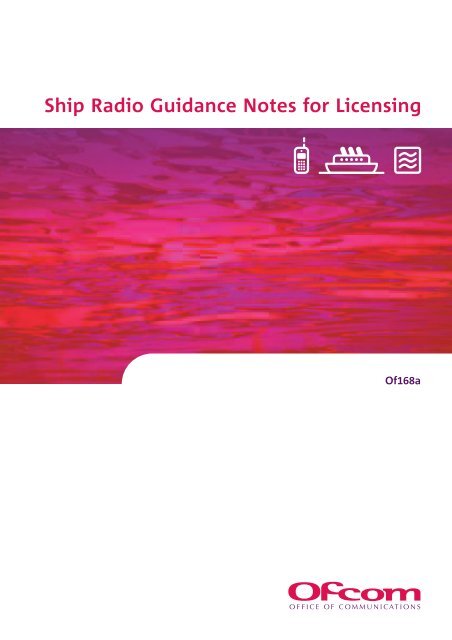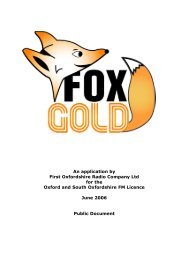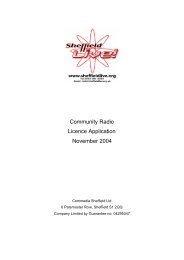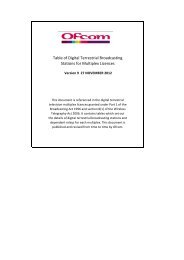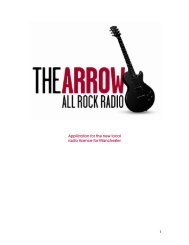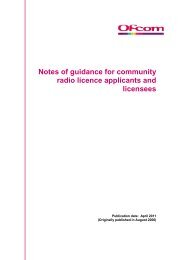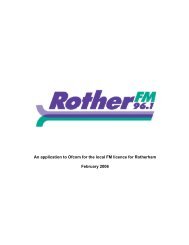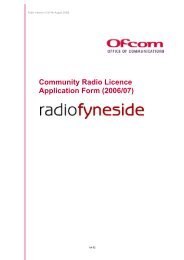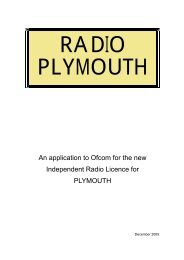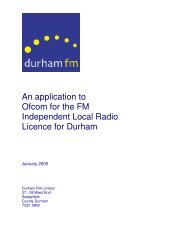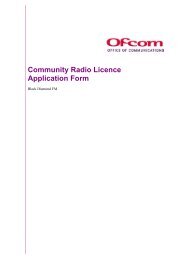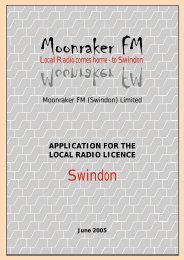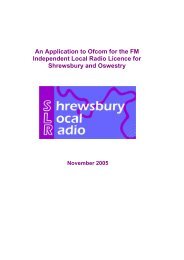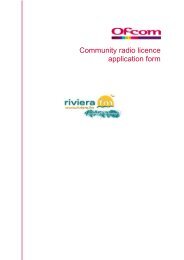Ship Radio Guidance Notes for Licensing - Ofcom Licensing
Ship Radio Guidance Notes for Licensing - Ofcom Licensing
Ship Radio Guidance Notes for Licensing - Ofcom Licensing
Create successful ePaper yourself
Turn your PDF publications into a flip-book with our unique Google optimized e-Paper software.
<strong>Ship</strong> <strong>Radio</strong> <strong>Guidance</strong> <strong>Notes</strong> <strong>for</strong> <strong>Licensing</strong><br />
Of168a
Contents<br />
Contents 3<br />
Page<br />
1. Introduction 4<br />
2. <strong>Ship</strong> <strong>Radio</strong> Licence 5<br />
3. <strong>Ship</strong> Portable <strong>Radio</strong> Licence 6<br />
4. <strong>Radio</strong> equipment con<strong>for</strong>mity requirements 7<br />
5. Vessel call signs 8<br />
6. Maritime Mobile Service Identity (MMSI) numbers 9<br />
7. Selective calling (Selcall) numbers 10<br />
8. Term of licence and payment of licence fees <strong>for</strong> the<br />
<strong>Ship</strong> <strong>Radio</strong> licence and the <strong>Ship</strong> Portable <strong>Radio</strong> licence 10<br />
9. Other licensing in<strong>for</strong>mation 11<br />
10. Maritime Mobile Access and Retrieval System (MARS) database 12<br />
11. International maritime VHF frequencies table 14<br />
12. Emergency Position Indicating <strong>Radio</strong> Beacons (EPIRBs) and<br />
Personal Locator Beacons (PLBs) 16<br />
13. Maritime <strong>Radio</strong> Operator’s certificate 17<br />
14. United Kingdom telephone calls 18<br />
15. Foreign calls 18<br />
16. Visual Signal Letters (VSL) 19<br />
17. Use of amateur radio stations on board UK licensed ships 19<br />
18. Inmarsat Point of Service Activation 20<br />
19. Maritime (radio) accounting authorities and contact details 20<br />
20. Symbols which designate classes of ships 22<br />
21. Contacts <strong>for</strong> further in<strong>for</strong>mation 24
4 <strong>Ship</strong> <strong>Radio</strong> <strong>Guidance</strong> <strong>Notes</strong> <strong>for</strong> <strong>Licensing</strong><br />
1. Introduction<br />
Please note that licence applicants are encouraged to register, apply <strong>for</strong> and<br />
print their <strong>Ship</strong> <strong>Radio</strong> or <strong>Ship</strong> Portable <strong>Radio</strong> licences via the <strong>Ofcom</strong> website.<br />
This entitles you to a free licence. <strong>Licensing</strong> amendments can also be notified<br />
via the <strong>Ofcom</strong> website, however, they are not charged <strong>for</strong> whether done via the<br />
website or by post.<br />
1.1 These notes are designed to help those applying <strong>for</strong> a <strong>Ship</strong> <strong>Radio</strong> licence or<br />
<strong>Ship</strong> Portable <strong>Radio</strong> licence. The notes cover the types of equipment that<br />
are licensable, specific requirements that the equipment must meet, radio<br />
operators certificates, Accounting Authorities, call signs, Maritime Mobile<br />
Service Identities and other licensing in<strong>for</strong>mation that applicants need to be<br />
aware of.<br />
1.2 If the application <strong>for</strong>m is not fully completed it may be returned to you in<br />
order to supply the missing details. If you are uncertain about the<br />
in<strong>for</strong>mation required, please contact the Office of Communications (<strong>Ofcom</strong>)<br />
– See Section 21 <strong>for</strong> contact details.<br />
1.3 <strong>Ofcom</strong> is responsible <strong>for</strong> the effective management of the civil radio<br />
spectrum in the United Kingdom. Regulation is necessary to ensure that<br />
those who use radio equipment can do so without causing or suffering<br />
from undue interference.<br />
1.4 The regulations governing the use of maritime radio are detailed in the<br />
International <strong>Radio</strong> Regulations, set by the International Telecommunication<br />
Union (ITU), and the Wireless Telegraphy Act 2006. It is an offence to install<br />
or use any radio equipment on board a UK ship, craft, hovercraft, lightship or<br />
any other vessel predominantly moored in UK waters without a radio licence.<br />
This includes vessels registered in the Channel Islands and the Isle of Man.<br />
A <strong>Ship</strong> <strong>Radio</strong> licence is required even if the transmitting equipment is not in<br />
constant use, or if it is used only <strong>for</strong> distress purposes.
2. <strong>Ship</strong> <strong>Radio</strong> licence<br />
<strong>Ship</strong> <strong>Radio</strong> <strong>Guidance</strong> <strong>Notes</strong> <strong>for</strong> <strong>Licensing</strong> 5<br />
2.1 The <strong>Ship</strong> <strong>Radio</strong> licence allows the licensee to install and if the relevant<br />
Maritime <strong>Radio</strong> Operators’ Certificate of Competence and Authority to<br />
Operate is held, use any combination of maritime radio equipment listed<br />
below on a specified vessel.<br />
– Digital Selective Calling (DSC) equipment associated with the Global<br />
Maritime Distress & Safety System (GMDSS);<br />
– MF, HF, VHF equipment;<br />
– Satellite communications equipment (<strong>Ship</strong> Earth Stations);<br />
– RADAR; Search and Rescue Radar Transponders (SARTs);<br />
– Low powered, on board maritime UHF communications equipment;<br />
– UHF On board repeater stations;<br />
– 121.5/123.1 MHz Aeronautical Search and Rescue equipment;<br />
– 121.5/243 MHz and 406/121.5 MHz Emergency Position Indicating <strong>Radio</strong><br />
Beacons (EPIRBs) and Personal Locator Beacons (PLBs), and 1.6 GHz<br />
EPIRBs (these are becoming obsolete).<br />
2.2 VHF or VHF/DSC portable radios may only be used where these are not<br />
intended to be used on multiple vessels under the cover of a <strong>Ship</strong> Portable<br />
<strong>Radio</strong> Licence, see Section 3.<br />
2.3 The <strong>Ship</strong> <strong>Radio</strong> licence will comprise of the licence details and the terms.<br />
2.4 Licensees will be able to use an unlimited number of declared VHF and UHF<br />
handportables on the vessel identified in the licence. None of the equipment<br />
covered by this licence, including safety equipment such as maritime EPIRBs<br />
and PLBs is licensed <strong>for</strong> use on land. A Licence will be needed even if<br />
EPIRBs/PLBs are the only type of radio equipment carried on board the<br />
vessel. VHF/DSC portables are only licensed <strong>for</strong> use in UK territorial waters.<br />
2.5 The equipment is authorised <strong>for</strong> operation on international maritime<br />
frequencies only. Additionally, Channel M (157.850 MHz) and Channel M2<br />
(161.425 MHz) is available <strong>for</strong> use in United Kingdom territorial waters only.<br />
Details of the international maritime VHF frequencies are listed in Section<br />
11. In order <strong>for</strong> the equipment to be authorised <strong>for</strong> use, it has to per<strong>for</strong>m in<br />
accordance with relevant technical parameters; see Section 4.
6 <strong>Ship</strong> <strong>Radio</strong> <strong>Guidance</strong> <strong>Notes</strong> <strong>for</strong> <strong>Licensing</strong><br />
3. <strong>Ship</strong> Portable <strong>Radio</strong> Licence<br />
3.1 For licensing purposes, a portable maritime radio is defined as a handheld<br />
portable VHF or VHF/DSC radio transceiver with an integral antenna and<br />
power supply which is not designed to be permanently installed on a vessel<br />
and which will be used on a number of different vessels.<br />
3.2 The <strong>Ship</strong> Portable <strong>Radio</strong> licence allows the licensee to have ‘available <strong>for</strong><br />
use’ one VHF portable maritime radio and/or one VHF DSC portable<br />
maritime radio. These must have an integral antenna and power supply.<br />
Together with the relevant Maritime <strong>Radio</strong> Operators’ Certificate of<br />
Competence and Authority to Operate, the <strong>Ship</strong> Portable <strong>Radio</strong> licence<br />
allows the use of international maritime radio channels. Within UK<br />
territorial waters it also authorises use of the UK Marine channels M<br />
(157.850 MHz) and M2 (161.425 MHz).<br />
3.3 The <strong>Ship</strong> Portable <strong>Radio</strong> licence will additionally cover the use of one<br />
Personal Locator Beacon (PLB) and/or one Emergency Position Indicating<br />
<strong>Radio</strong> Beacon (EPIRB) operating on 121.5 MHz or 121.5/243 MHz, 406 MHz<br />
or 406/121.5 MHz or 1.6 GHz (these are becoming obsolete). Units<br />
incorporating 406 MHz beacons (including those 406 MHz beacons which<br />
incorporate 121.5 MHz) must be correctly registered with HM Coastguard.<br />
3.4 The <strong>Ship</strong> Portable <strong>Radio</strong> licence may also include one piece of aeronautical<br />
search and rescue radio equipment with frequencies 121.5 and 123.1 MHz.<br />
3.5 Applicants should note that the use of VHF/DSC Portable maritime radio<br />
equipment under a <strong>Ship</strong> Portable <strong>Radio</strong> Licence is only permitted in UK<br />
territorial waters.<br />
3.6 The <strong>Ship</strong> Portable <strong>Radio</strong> Licence will comprise of the licence details and the<br />
terms.<br />
3.7 None of the equipment covered by this licence is permitted to be used on land.<br />
3.8 All equipment covered by this licence must per<strong>for</strong>m in accordance with the<br />
relevant per<strong>for</strong>mance requirements, as detailed in Section 4.0.
4. <strong>Radio</strong> equipment con<strong>for</strong>mity<br />
requirements<br />
<strong>Ship</strong> <strong>Radio</strong> <strong>Guidance</strong> <strong>Notes</strong> <strong>for</strong> <strong>Licensing</strong> 7<br />
4.1 Equipment built to Merchant <strong>Ship</strong>ping Standards: Any radio, radar or<br />
navigation equipment Type Approved under the European Marine<br />
Equipment Directive has been entirely acceptable <strong>for</strong> use on all UK vessels<br />
since 1 Jan 1999 and will continue to be acceptable <strong>for</strong> the <strong>for</strong>eseeable<br />
future. Such equipment bears the Wheel Mark.<br />
4.2 Equipment Con<strong>for</strong>ming to the Requirements of the European <strong>Radio</strong><br />
Equipment and Telecommunications Terminal Equipment (R&TTE) Directive:<br />
Since 8 April 2000, all new maritime radio and radar equipment (apart from<br />
equipment with a Wheel Mark) has had to comply with the R&TTE Directive<br />
be<strong>for</strong>e being placed on the market. Such equipment may also be licensed<br />
<strong>for</strong> use on voluntary fit craft in the UK, provided it meets the relevant UK<br />
<strong>Radio</strong> Interface Requirement.<br />
4.3 Such equipment must bear the CE Mark, the identification number of a<br />
Notified Body (where one has been consulted by the manufacturer as part<br />
of the con<strong>for</strong>mity assessment procedure), and where appropriate, the Alert<br />
Symbol (which signifies that there may be restrictions on how the<br />
equipment may be used or that the equipment may not necessarily be put<br />
into service in all EU States).<br />
The equipment will have been issued with:<br />
a) A copy of the Declaration of Con<strong>for</strong>mity to the requirements of the R&TTE<br />
Directive (or a simplified Statement of Compliance and in<strong>for</strong>mation on<br />
where the <strong>for</strong>mal Declaration of Con<strong>for</strong>mity may be found).<br />
b) In<strong>for</strong>mation on its intended use, including the countries of the EU in<br />
which it is intended <strong>for</strong> the equipment to be used. Equipment, which<br />
additionally meets the requirements of any of the European Standards<br />
(ETS or EN) or International standards (IEC) is recommended.<br />
4.4 Equipment previously approved under national type approval<br />
arrangements: it has remained permissible to sell equipment Type<br />
Approved prior to 8 April 2000 and some may still have been on the market
8 <strong>Ship</strong> <strong>Radio</strong> <strong>Guidance</strong> <strong>Notes</strong> <strong>for</strong> <strong>Licensing</strong><br />
when the R&TTE Directive came into fully into <strong>for</strong>ce on 8 April 2001. This<br />
equipment will have been Type Approved to one or more of the applicable<br />
standards and customers are advised to confirm this with the supplier.<br />
Nationally Type Approved equipment may continue to be licensed and<br />
installed on vessels but, since 8 April 2001, further supplies of such<br />
equipment may not be transferred from manufacturers or importers to<br />
retailers.<br />
4.5 UK <strong>Radio</strong> Interface Requirements applicable to maritime radio equipment<br />
<strong>for</strong> voluntary fit craft under the R&TTE Directive: <strong>Radio</strong> Interface<br />
Requirements are high level descriptions of how the spectrum should be<br />
used. They typically consist of the requirements related to intentional<br />
transmissions in allocated frequency bands. They do not prescribe technical<br />
interpretations of the essential requirements of the R&TTE Directive. The<br />
documents and a comprehensive list are available on the <strong>Ofcom</strong> website:<br />
www.ofcom.org.uk<br />
5. Vessel call signs<br />
5.1 A call sign is allocated to the vessel when first issued with a <strong>Ship</strong> <strong>Radio</strong><br />
Licence. It uniquely identifies the vessel within the International Maritime<br />
Mobile Service. The call sign remains with the vessel <strong>for</strong> the duration of its<br />
life regardless of changes of ownership or even vessel name. However, the<br />
call sign is surrendered if the vessel ceases to be classed as a UK vessel, is<br />
destroyed or is unlicensed <strong>for</strong> a period of two or more years. There<strong>for</strong>e every<br />
ef<strong>for</strong>t should be made to ensure that the call sign remains with the vessel.<br />
5.2 Call signs cannot be transferred between vessels.<br />
5.3 T-numbers (UK based call signs) are issued with <strong>Ship</strong> Portable <strong>Radio</strong><br />
licences, as these radios are not intended <strong>for</strong> use on one vessel only.
<strong>Ship</strong> <strong>Radio</strong> <strong>Guidance</strong> <strong>Notes</strong> <strong>for</strong> <strong>Licensing</strong> 9<br />
6. Maritime Mobile Service Identity<br />
(MMSI) numbers<br />
6.1 A Maritime Mobile Service Identity (MMSI) number uniquely identifies a<br />
vessel and is only issued to vessels fitted with Digital Selective Calling (DSC)<br />
and/or (Satellite) <strong>Ship</strong> Earth Station (SES) equipment. The UK administration<br />
does not normally issue MMSI numbers to EPIRBs/PLBs.<br />
6.2 In order to use SES equipment, arrangements must be made with an<br />
Inmarsat Point of Service Activation Entity see Section 18 of these <strong>Guidance</strong><br />
<strong>Notes</strong>. An MMSI number is required be<strong>for</strong>e the equipment can be<br />
commissioned.<br />
6.3 If an MMSI has already been issued <strong>for</strong> use with DSC equipment and<br />
subsequently a satellite earth station terminal is installed, if a new MMSI is<br />
required, the DSC equipment may need to be re-programmed. MMSIs issued<br />
(as described above) are free of charge as part of a <strong>Ship</strong> <strong>Radio</strong> Licence.<br />
6.4 <strong>Ofcom</strong> notifies the ITU of all vessel MMSI numbers issued by the UK,<br />
however it does not notify Portable MMSI numbers. MMSIs are also made<br />
available to HM Coastguard to assist in Search and Rescue operations.<br />
6.5 With the advent of VHF/DSC portable radios in 2001 <strong>Ofcom</strong> has set aside a<br />
unique block of MMSI numbers which will be allocated only to this<br />
equipment. This enables HM Coastguard to differentiate between alerts sent<br />
from fixed and portable VHF/DSC radio equipment. However, such<br />
equipment is no longer being produced in the UK and consequently <strong>Ofcom</strong><br />
only envisages licensing equipment that is only currently on the market.<br />
6.6 Portable VHF/DSC radios must on no account be programmed with the<br />
vessel MMSI numbers. HM Coastguard needs to be able to differentiate<br />
between the types of equipment sending a DSC alert, as it is possible <strong>for</strong><br />
the DSC alert from a transportable radio to come from any vessel. The<br />
resulting search on the database <strong>for</strong> vessel details may provide incorrect<br />
in<strong>for</strong>mation that could jeopardise a Search and Rescue operation. The first<br />
four digits of a ‘portable’ MMSI will generally be 2359.
10 <strong>Ship</strong> <strong>Radio</strong> <strong>Guidance</strong> <strong>Notes</strong> <strong>for</strong> <strong>Licensing</strong><br />
7. Selective calling (Selcall) numbers<br />
7.1 A Selcall number is a code which when programmed into a radio receiver<br />
will ensure that the receiver will respond only to calls addressed to it.<br />
7.2 This system is becoming obsolete and <strong>Ofcom</strong> does not envisage licensing<br />
any new Selcall numbers unless specifically requested.<br />
8. Term of licence and payment of<br />
licence fees <strong>for</strong> the <strong>Ship</strong> <strong>Radio</strong> licence<br />
and the <strong>Ship</strong> Portable <strong>Radio</strong> licence<br />
8.1 Licence applicants are encouraged to apply via the <strong>Ofcom</strong> website – See<br />
Sections 1 and 21.<br />
8.2 Licences applied <strong>for</strong> and granted via the <strong>Ofcom</strong> website will be free.<br />
8.3 A fee of £20 will be charged <strong>for</strong> each <strong>Ship</strong> <strong>Radio</strong> licence and each <strong>Ship</strong><br />
Portable <strong>Radio</strong> licence that is not applied <strong>for</strong> and downloaded from the<br />
<strong>Ofcom</strong> website.<br />
8.4 A discount is no longer granted <strong>for</strong> charities as free licences are available<br />
via the <strong>Ofcom</strong> website.<br />
8.5 Licences shall continue in <strong>for</strong>ce unless revoked by <strong>Ofcom</strong> or surrendered by<br />
the licensee.<br />
8.6 The licensee must notify <strong>Ofcom</strong> of all changes to their Licence details when<br />
such changes occur and must provide confirmation to <strong>Ofcom</strong> that all their<br />
Licence details are correct, at least once every ten (10) years.<br />
8.7 <strong>Licensing</strong> amendments can also be notified via the <strong>Ofcom</strong> website and are<br />
not charged <strong>for</strong> whether done via the website or by post.<br />
8.8 Warning: it is an offence to use or install maritime radio equipment other<br />
than in accordance with the terms of a licence issued by <strong>Ofcom</strong>.<br />
8.9 Refunds will only be made where there has been an overpayment, duplicate<br />
payment or when a licence application has been unsuccessful.
<strong>Ship</strong> <strong>Radio</strong> <strong>Guidance</strong> <strong>Notes</strong> <strong>for</strong> <strong>Licensing</strong> 11<br />
Please note that licence fees may vary from time-to-time and are set by<br />
<strong>Ofcom</strong>, with the approval of Parliament.<br />
8.10 The current list of payment methods and fees can be found in the <strong>Ship</strong><br />
<strong>Radio</strong> licence and the <strong>Ship</strong> Portable <strong>Radio</strong> licence application <strong>for</strong>ms.<br />
9. Other licensing in<strong>for</strong>mation<br />
Registration<br />
9.1 A vessel does not need to be registered with an official body be<strong>for</strong>e an<br />
application <strong>for</strong> a <strong>Ship</strong> <strong>Radio</strong> licence is made. Under normal circumstances,<br />
<strong>Ofcom</strong> is not able to licence vessels registered in countries other than the<br />
UK, Isle of Man and Channel Islands. Vessels transferring away from the UK<br />
Flag to other Flag states must surrender their UK licence.<br />
9.2 When a vessel needs to be registered to comply with the Merchant <strong>Ship</strong>ping<br />
(Registration) Act 1993, details may be obtained from The Registrar General,<br />
Maritime and Coastguard Agency. See Section 21 <strong>for</strong> contact details.<br />
9.3 All changes to the <strong>Ship</strong> <strong>Radio</strong> licence or <strong>Ship</strong> Portable <strong>Radio</strong> licence details,<br />
e.g. change of owner’s address, radio equipment etc. must be notified to<br />
<strong>Ofcom</strong> in writing using the appropriate <strong>for</strong>m Of 347. There is no charge <strong>for</strong><br />
registering amendments.<br />
9.4 The <strong>Ship</strong> <strong>Radio</strong> licence must be kept with the radio equipment especially if<br />
the vessel is taken abroad. Foreign licensing administrations may confiscate<br />
the radio equipment or even detain the vessel, where a valid <strong>Ship</strong> <strong>Radio</strong><br />
licence cannot be produced on demand.<br />
9.5 Company applications – Whilst <strong>Ofcom</strong> is able to accept applications where a<br />
company is named as the licensee, a named contact must also be specified,<br />
and will be the first point of contact with <strong>Ofcom</strong>. If the company box is<br />
ticked, the applicant is declaring that the licensee is a limited company, and<br />
a company registration number must be supplied. If the company is not a<br />
limited company then another appropriate box should be ticked.
12 <strong>Ship</strong> <strong>Radio</strong> <strong>Guidance</strong> <strong>Notes</strong> <strong>for</strong> <strong>Licensing</strong><br />
10. Maritime Mobile Access and<br />
Retrieval System (MARS) database<br />
10.1 The ITU requires <strong>Ofcom</strong> to collect in<strong>for</strong>mation about vessels being licensed<br />
and what equipment is being used. This in<strong>for</strong>mation is held on the ITU’s<br />
Maritime Mobile Access and Retrieval System (MARS) database which is<br />
supplied <strong>for</strong> the use of Search and Rescue organisations worldwide.<br />
10.2 Section 3 of the (application) <strong>for</strong>m asks <strong>for</strong> in<strong>for</strong>mation such as the gross<br />
tonnage of a vessel, its type and how many people it can carry. <strong>Ofcom</strong> is<br />
obliged to supply this in<strong>for</strong>mation to the ITU and so if it is not completed in<br />
full on the application <strong>for</strong>m <strong>Ofcom</strong> will be unable to issue a licence and the<br />
application <strong>for</strong>m will be returned to the applicant.<br />
10.3 Additional in<strong>for</strong>mation which the ITU records on its MARS database is<br />
collected in Section 7 of the (application) <strong>for</strong>m. This in<strong>for</strong>mation is not<br />
mandatory and a licence can be issued even if it is not supplied. It is<br />
anticipated that much of this in<strong>for</strong>mation is only relevant to larger<br />
passenger carrying vessels which routinely sail out of UK territorial waters.<br />
10.4 The national telex number and Selcall number should be supplied where<br />
these have has been issued to the vessel. Please note that the Selcall system<br />
is becoming obsolete and new numbers should be requested only if needed.<br />
10.5 Both the General Classification and Individual Classification fields are <strong>for</strong><br />
codes that identify the type of vessel. A full list of these codes is given in<br />
Section 20 of these <strong>Guidance</strong> <strong>Notes</strong>.<br />
10.6 The nature of service includes the classification as regards the type of<br />
international correspondence service maintained by the station, indicated<br />
by the following codes:<br />
CO – a station open to official correspondence exclusively<br />
CP – a station open to public correspondence<br />
CR – a station open to limited public correspondence<br />
CV – a station open exclusively to correspondence of a private agency<br />
OT – a station open exclusively to operational traffic of the service<br />
concerned
<strong>Ship</strong> <strong>Radio</strong> <strong>Guidance</strong> <strong>Notes</strong> <strong>for</strong> <strong>Licensing</strong> 13<br />
10.7 Services available refers to the specific services provided by a station open<br />
to public correspondence. The services available are indicated by one or<br />
more of the following codes:<br />
C – radiotelephone calls<br />
D – radiotelex calls<br />
O – OBS messages (voluntary observing <strong>Ship</strong>)<br />
P – facsimile communications<br />
R – radiotelegrams<br />
10.8 Hours of service refers to the availability of the public correspondence<br />
services offered by a vessel. This should be indicated by one of the<br />
following codes:<br />
H24 – continuous service throughout the twenty four hours<br />
H16 – 16 hour service provided by a ship station of the second category<br />
H8 – 8 hour service provided by a ship station of the third category<br />
HX – intermittent service throughout the twenty four hours, or station<br />
having no specific working hours (generally applicable to pleasure<br />
craft)<br />
HJ – day service<br />
HN – night service
14 <strong>Ship</strong> <strong>Radio</strong> <strong>Guidance</strong> <strong>Notes</strong> <strong>for</strong> <strong>Licensing</strong><br />
11. International maritime VHF<br />
frequencies table<br />
Table 1: Use of International Maritime Mobile VHF Channels<br />
Channel<br />
designators <strong>Notes</strong><br />
Transmitting frequencies<br />
(MHz)<br />
<strong>Ship</strong> stations Coast stations<br />
Intership<br />
Port operation<br />
and ship movement<br />
Single<br />
frequency<br />
Two<br />
frequency<br />
Public<br />
correspondence<br />
60 156.025 160.625 <br />
01 156.050 160.650 <br />
61 156.075 160.675 <br />
02 156.100 160.700 <br />
62 156.125 160.725 <br />
03 156.150 160.750 <br />
63 156.175 160.775 <br />
04 156.200 160.800 <br />
64 156.225 160.825 <br />
05 156.250 160.850 <br />
65 156.275 160.875 <br />
06 1 156.300 <br />
66 156.325 160.925 <br />
07 156.350 160.950 <br />
67 156.375 156.375 <br />
08 156.400 <br />
68 156.425 156.425 <br />
09 156.450 156.450 <br />
69 156.475 156.475 <br />
10 5 156.500 156.500 <br />
70 6 156.525 156.525<br />
Digital selective calling <strong>for</strong> distress, safety and calling only<br />
11 156.550 156.550 <br />
71 156.575 156.575 <br />
12 156.600 156.600 <br />
72 156.625 <br />
13 7 156.650 156.650 <br />
73 5 156.675 156.675 <br />
14 156.700 156.700 <br />
HMCG SAR<br />
Oil pollution<br />
HMCG SAR
Channel<br />
designators <strong>Notes</strong><br />
Transmitting frequencies<br />
(MHz)<br />
<strong>Ship</strong> stations Coast stations<br />
<strong>Ship</strong> <strong>Radio</strong> <strong>Guidance</strong> <strong>Notes</strong> <strong>for</strong> <strong>Licensing</strong> 15<br />
Intership<br />
Port operation<br />
and ship movement<br />
Single<br />
frequency<br />
74 156.725 156.725 <br />
15 2 156.750 156.750 <br />
Two<br />
frequency<br />
75 4 156.775<br />
16 156.800 156.800<br />
Distress, safety and calling<br />
76 4 156.825 <br />
17 2 156.850 160.850 <br />
77 156.875 <br />
Public<br />
correspondence<br />
18 156.900 161.500 <br />
78 156.925 161.525 <br />
19 156.950 161.550 <br />
79 156.975 161.575 <br />
20 157.000 161.600 <br />
80 157.025 161.625 Also Marinas etc UK only <br />
21 157.050 161.650 <br />
81 157.075 161.675 <br />
22 157.100 161.700 <br />
82 157.125 161.725 <br />
23 157.150 161.750<br />
HMCG SAR/MSI<br />
83 157.175 161.775 <br />
24 157.200 161.800 <br />
84 157.225 161.825 <br />
25 157.250 161.850 <br />
85 157.275 161.875 <br />
26 157.300 161.900 <br />
86 157.325 161.925 <br />
27 157.350 161.950 <br />
87 157.375 <br />
28 157.400 162.000 <br />
88 157.425 <br />
AIS 1 3 161.975 161.975<br />
AIS 2 3 162.025 162.025<br />
Also on-board comms<br />
Also on-board comms<br />
HMCG SAR/MSI<br />
HMCG SAR/MSI
16 <strong>Ship</strong> <strong>Radio</strong> <strong>Guidance</strong> <strong>Notes</strong> <strong>for</strong> <strong>Licensing</strong><br />
<strong>Notes</strong> to Table 1<br />
1. Channel 06 may also be used <strong>for</strong> communications between ship stations and aircraft<br />
engaged in co-ordinated search and rescue operations. <strong>Ship</strong> stations must avoid harmful<br />
interference to such communications on Channel 06, as well as to communications<br />
between aircraft stations, ice breakers and assisted ships during ice seasons.<br />
2. Channels 15 and 17 may also be used <strong>for</strong> onboard communications, provided that the<br />
effective radiated power does not exceed 1 Watt.<br />
3. Channels AIS 1 and AIS 2 are used <strong>for</strong> an automatic ship identification/surveillance<br />
system, capable of operating worldwide on the high seas, unless other frequencies are<br />
designated on a regional basis <strong>for</strong> this purpose.<br />
4. Channels 75 and 76 should be used <strong>for</strong> navigation-related communication only. All<br />
precautions should be taken to avoid harmful interference to Channel 16, e.g. by<br />
limiting power to 1 Watt or by means of geographical location.<br />
5. These channels (10 or 73 depending on location) are also used by the Maritime and<br />
Coastguard Agency to broadcast Marine Safety In<strong>for</strong>mation in the UK only.<br />
6. Channel 70 must be used exclusively <strong>for</strong> Digital Selective Calling <strong>for</strong> distress, safety and<br />
calling.<br />
7. Channel 13 is designated <strong>for</strong> use on a worldwide basis as a navigation safety<br />
communication channel, primarily <strong>for</strong> inter-ship navigation safety communications.<br />
12. Emergency Position Indicating <strong>Radio</strong><br />
Beacons (EPIRBs) and Personal<br />
Locator Beacons (PLBs)<br />
12.1 Emergency Position Indicating <strong>Radio</strong> Beacons (EPIRBs) and Personal Locator<br />
Beacons (PLBs) are self contained battery operated radio transmitters, the<br />
purpose of which is to facilitate search and rescue operations. EPIRBs and<br />
PLBs are intended <strong>for</strong> marine use only and should not be used on land.<br />
12.2 There are several types of EPIRBs and PLBs in use in the United Kingdom;<br />
those that operate on the aeronautical distress frequencies 121.5 MHz or<br />
121.5 MHz and 243 MHz and more sophisticated models operating on 406<br />
MHz/121.5 MHz and 1.6 GHz (these are becoming obsolete). These latter<br />
two have a unique identification code, which identifies the vessel to which<br />
it has been registered.
<strong>Ship</strong> <strong>Radio</strong> <strong>Guidance</strong> <strong>Notes</strong> <strong>for</strong> <strong>Licensing</strong><br />
12.3 It is vital that all EPIRBs and PLBs using the frequency band 406 MHz are<br />
registered with the Maritime and Coastguard Agency (MCA). The details<br />
provide the rescue co-ordination centres with in<strong>for</strong>mation needed to assist<br />
a search and rescue operation. Failure to register an EPIRB will seriously<br />
degrade its usefulness to the search and rescue services in the event of an<br />
emergency and could even put lives at risk.<br />
406 MHz EPIRBs and PLBs<br />
12.4 The details provided in Section 4 of the <strong>Ship</strong> <strong>Radio</strong> Licence application <strong>for</strong>m<br />
will be sent to the MCA EPIRB Registry. After having applied <strong>for</strong> a <strong>Ship</strong> <strong>Radio</strong><br />
Licence, should you acquire, or transfer a 406 MHz EPIRB or PLB to another<br />
owner and/or vessel, the MCA EPIRB Registry must be notified. In addition,<br />
<strong>Ofcom</strong> must be advised via the <strong>Ofcom</strong> website or in writing using the<br />
appropriate <strong>for</strong>m Of347 available from <strong>Ofcom</strong>. See Section 21. There is no<br />
charge <strong>for</strong> registering amendments.<br />
1.6 GHz EPIRBs<br />
12.5 1.6 GHz EPIRBs (these are becoming obsolete) must be registered with the<br />
Inmarsat Customer Activation Group (CAG), Telephone 020 7728 1372, fax<br />
020 7728 1142. After having applied <strong>for</strong> a <strong>Ship</strong> <strong>Radio</strong> Licence, should you<br />
acquire, or transfer a 1.6 GHz EPIRB to another owner and/or vessel,<br />
Inmarsat CAG must be notified. In addition, <strong>Ofcom</strong> must be notified via the<br />
<strong>Ofcom</strong> website or in writing.<br />
12.6 An in<strong>for</strong>mation sheet (Of19a) concerning the safe handling of EPIRBs is<br />
available free of charge from the <strong>Ofcom</strong> Contact Centre. See Section 21.<br />
13. Maritime <strong>Radio</strong> Operator’s<br />
certificate<br />
13.1 Whilst it is not necessary to hold a Certificate of Competence in order to<br />
obtain a <strong>Ship</strong> <strong>Radio</strong> Licence or a <strong>Ship</strong> Portable <strong>Radio</strong> Licence, a maritime<br />
radio may be operated only by or under the direct personal supervision of a<br />
holder of the appropriate Certificate of Competence and Authority to<br />
Operate (normally granted by the Secretary of State. This is to maintain<br />
operational standards and ensure knowledge of current distress, emergency<br />
17
18 <strong>Ship</strong> <strong>Radio</strong> <strong>Guidance</strong> <strong>Notes</strong> <strong>for</strong> <strong>Licensing</strong><br />
and safety procedures. The certificate holder is required to produce these<br />
documents when requested to do so by a person authorised by <strong>Ofcom</strong>.<br />
13.2 The minimum Certificate of Competence that is required <strong>for</strong> use of a ship<br />
radio is the Short Range Certificate. This certificate covers use of both<br />
standard VHF and VHF/DSC equipment under the Global Maritime Distress<br />
and Safety System in sea area A1. Please note that other relevant<br />
certificates may be required <strong>for</strong> vessels where radio fit is compulsory and<br />
may also depend on the sea areas of operation. Further guidance may be<br />
obtained from the Maritime and Coastguard Agency. See Section 21.<br />
14. United Kingdom telephone calls<br />
14.1 In June 1999 British Telecom ceased providing many commercial maritime<br />
services through its coast stations due to a substantial decline in demand.<br />
14.2 These services included the provision of link calls made from a vessel to the<br />
UK public telephone network. There are currently no plans <strong>for</strong> another<br />
organisation to provide this service.<br />
14.3 The Maritime and Coastguard Agency has assumed responsibility <strong>for</strong><br />
providing maritime safety in<strong>for</strong>mation and medical link calls previously<br />
provided by BT coast stations.<br />
15. Foreign calls<br />
15.1 In order to make a call using a <strong>for</strong>eign coast station, the licensee must have<br />
first entered into a contract with a Maritime <strong>Radio</strong> Accounting Authority<br />
(MRAA) and be able to quote the relevant Accounting Authority<br />
Identification Code (AAIC) to the coast station operator.<br />
15.2 Coast stations will usually hold a copy of the ITU list of ship stations. This<br />
may give details of the MRAA that the vessel is using as its agent <strong>for</strong> billing<br />
purposes. In turn, that MRAA will invoice the licensee, <strong>for</strong> any call charges<br />
incurred. The ship station details will be sent to the ITU <strong>for</strong> inclusion in
<strong>Ship</strong> <strong>Radio</strong> <strong>Guidance</strong> <strong>Notes</strong> <strong>for</strong> <strong>Licensing</strong> 19<br />
their list of ship stations when applying <strong>for</strong>, or amending a licence.<br />
In<strong>for</strong>mation supplied by the Maritime <strong>Radio</strong> Accounting Authorities will be<br />
used to update in<strong>for</strong>mation against the relevant ship station.<br />
15.3 In<strong>for</strong>mation on MRAAs is available from the <strong>Ofcom</strong> in<strong>for</strong>mation sheet Of19a<br />
entitled <strong>Ship</strong> <strong>Radio</strong> In<strong>for</strong>mation.<br />
16. Visual Signal Letters (VSL)<br />
16.1 VSLs are flags or combination of flags used be<strong>for</strong>e radio as a means of<br />
identification and communication. A vessel that previously has used VSLs may<br />
retain them as its call sign upon application. Where this is required, a <strong>for</strong>mal<br />
written application must be made, and included with the application <strong>for</strong>m.<br />
17. Use of amateur radio stations on<br />
board UK licensed ships<br />
17.1 The establishment and use of amateur radio stations on board United<br />
Kingdom licensed ships is permitted under the Amateur <strong>Radio</strong> Licence,<br />
granted by <strong>Ofcom</strong>. On board a vessel, the licensee shall:<br />
a) install, use or make changes to the station only with the written<br />
permission of the vessel’s master;<br />
b) observe radio silence when required by the vessel’s master.<br />
17.2 The full terms, provisions and limitations with which the licensee shall<br />
comply with are available from <strong>Ofcom</strong>. See Section 21.<br />
17.3 It is important to ensure that radio is used correctly. At sea, lives may<br />
depend upon this. Consequently, there are severe penalties <strong>for</strong> not keeping<br />
within the law and these include fines, imprisonment and the <strong>for</strong>feiture of<br />
anything used in connection with the offence. Those convicted of such<br />
offences may, in addition, face the revocation of their licence and the<br />
suspension of their Authority to operate.
20 <strong>Ship</strong> <strong>Radio</strong> <strong>Guidance</strong> <strong>Notes</strong> <strong>for</strong> <strong>Licensing</strong><br />
18. Inmarsat Point of Service Activation<br />
(PSA) entities<br />
18.1 Details of PSAs are available by contacting Inmarsat’s Customer Services<br />
Department. See Section 21.<br />
19. Maritime (radio) accounting<br />
authorities and contact details<br />
19.1 The following is a list of relevant Maritime radio accounting authorities.<br />
Please note that the list is being continually updated and the details should<br />
be checked with the relevant MRAA.<br />
19.2 It is your responsibility to set up an account with the relevant Maritime<br />
<strong>Radio</strong> Accounting Authority if you intend using radio equipment <strong>for</strong> public<br />
telecommunication calls through Coast or Coast earth stations. You also<br />
need to ensure that the Maritime <strong>Radio</strong> Accounting Authority is entitled to<br />
act on behalf of UK licensed vessels. Contact details of MRAAs are given<br />
below but please note that the list is being continually updated and the<br />
details should be checked with the relevant MRAA.<br />
The following list is subject to change. (Please telephone <strong>Ofcom</strong> to check<br />
the latest in<strong>for</strong>mation)<br />
A-N-D Group plc –<br />
(GBO1, GB05 & GB15)<br />
Tanners Bank<br />
North Shields<br />
Tyne & Wear NE30 1HJ<br />
Tel: 0191 258 1635<br />
Fax: 0191 296 4484<br />
International Marine<br />
<strong>Radio</strong> Company Ltd – (GB03)<br />
Morley House<br />
Badminton Court<br />
Church Street<br />
Amersham, Bucks HP7 ODA<br />
Tel: 01494 434000<br />
Fax: 01494 431993
F T Everard & Sons Ltd – (GB17)<br />
c/o <strong>Ship</strong>s Electronic Services Ltd<br />
Waterside Court<br />
Neptune Close<br />
Rochester Kent, ME2 4NZ<br />
Tel: 01634 295500<br />
Fax: 01634 295536<br />
Note: Commercial vessels only<br />
James Fisher Tankerships Ltd – (GB18)<br />
c/o <strong>Ship</strong>s Electronic Services Ltd<br />
Waterside Court<br />
Neptune Close<br />
Rochester<br />
Kent ME2 4NZ<br />
Tel: 01634 295500<br />
Fax: 01634 295536<br />
Note: Commercial vessels only<br />
Yacht Electronic Services (UK) Ltd –<br />
(GB20)<br />
2 Mill Row<br />
Bexley<br />
Kent DA5 1LA<br />
Tel: 01322 556633<br />
Fax: 01332 556634<br />
GEC-Marconi Communications<br />
Systems Ltd – (GB08/GB06)<br />
Marconi Marine Division<br />
Marconi House<br />
New Street,<br />
Chelms<strong>for</strong>d<br />
Essex CM1 1PL<br />
Tel: 01245 353221<br />
Fax: 01245 358776<br />
<strong>Ship</strong> <strong>Radio</strong> <strong>Guidance</strong> <strong>Notes</strong> <strong>for</strong> <strong>Licensing</strong> 21<br />
Nera Satellite Services – (GB11)<br />
20 Imperial Way<br />
Croydon<br />
Surrey CR0 4RR<br />
Tel: 020 8686 5701<br />
Fax: 020 8680 8206<br />
Helexco Co Ltd – (GB13)<br />
31 High Street<br />
Colliers Wood<br />
London SW19 2JE<br />
Tel: 020 8542 4916<br />
Fax: 020 8540 8047<br />
Telecom Italia S.P.A – (IU02)<br />
Viale Parco dei Medici<br />
9 Corpo Al Piano<br />
00148 Rome, Italy<br />
Tel: +39 9 368 80100<br />
Fax: +39 6 368 2431<br />
Email: andrea.vitali@telecomitalia.it<br />
Campagnia Generale Telemar – (IU03)<br />
Viale Tiziano, 19<br />
I-00196 Roma<br />
Italy<br />
Tel: +39 6 322 1800<br />
Fax: +39 6 324 0148<br />
Marlink – (BE02)<br />
80 Avg Henrinckxlaan<br />
B-1180 Brussels, Belgium<br />
Tel: +32 2 371 7111<br />
Fax: +32 2 371 7125<br />
N.B. The associated AAIC codes are<br />
shown in italics, alongside the<br />
company name.
22 <strong>Ship</strong> <strong>Radio</strong> <strong>Guidance</strong> <strong>Notes</strong> <strong>for</strong> <strong>Licensing</strong><br />
20. Symbols which designate classes<br />
of ships<br />
General classifications<br />
FV <strong>Ship</strong> of a fishing fleet<br />
GV Official service ship<br />
MM Merchant ship<br />
NF River vessel<br />
NS Naval ship<br />
PL Pleasure ship<br />
SV Rescue vessel<br />
XX Unspecified<br />
Individual classifications<br />
ACV Air-cushion vehicle<br />
AUX Auxiliary ship<br />
AVI Despatch vessel<br />
BAR Lighter<br />
BLK Bulk carrier<br />
BLN Whaler<br />
BLS Buoy ship<br />
BTA Factory ship<br />
CA Cargo ship<br />
CAB Coaster<br />
CBL Cable ship<br />
CGT Coast-guard<br />
CHA Barge<br />
CHR Trawler<br />
CIM Cement carrier<br />
CIT Tanker<br />
COA Collier<br />
CON Container ship<br />
COR Corvette<br />
CRO Cruiser<br />
CTR Cutter<br />
DES Destroyer<br />
DIV <strong>Ship</strong> used by divers<br />
DMN Minesweeper<br />
DOU Customs launch<br />
DRG Dredger<br />
DRY Dry cargo<br />
DUN Ketch<br />
ECO Training ship<br />
ESC Escort ship<br />
EXP Research ship/Survey ship<br />
FBT Ferry<br />
FPS Fast patrol ship<br />
FRG Reefer<br />
FRM Weather ship<br />
FRT Frigate<br />
FRU Fruit carrier<br />
GEN General cargo<br />
GOL Schooner<br />
GRC Grain carrier<br />
GRF Floating Crane<br />
GS Warship<br />
HOP Hospital ship<br />
HYD Hydrographic ship<br />
ICE Ice breaker<br />
ICN Waste incinerator<br />
INS Inspection ship
LAN Lobster ship<br />
LOU Lugger<br />
MOR Banker<br />
MOU Mine layer<br />
MTB Motor boat<br />
NET Pollution and surface clearance<br />
vessel<br />
NVP Naviplane<br />
OBO Ore-bulk-oil carrier<br />
OIL Oil tanker<br />
OSC Oceanographic ship<br />
OSV Ocean-station vessel<br />
PA Passenger ship<br />
PAQ Liner<br />
PBE Livestock carrier<br />
PCH Barge carrier<br />
PER Drilling unit<br />
PH Fishing vessel<br />
PHA Lightship<br />
PHR Lighthouse tender<br />
PHS Fishing guard<br />
PLE Plat<strong>for</strong>m<br />
PLT Pilot tender<br />
PMP Firefloat<br />
PMX Cargo and passenger<br />
PON Pontoon<br />
PTA Aircraft carrier<br />
PTH Helicopter carrier<br />
RAM Salvage ship<br />
RAV Supply vessel<br />
ROC Rock breaker<br />
ROU RoRo ship<br />
SAU Rescue vessel<br />
<strong>Ship</strong> <strong>Radio</strong> <strong>Guidance</strong> <strong>Notes</strong> <strong>for</strong> <strong>Licensing</strong> 23<br />
SEC Stand-by safety vessel<br />
SLO Sloop<br />
SMN Submarine<br />
SRV Patrol ship<br />
THO Tunny ship<br />
TPG Liquefied gas carrier<br />
TPO Ore carrier<br />
TPS Solvent carrier<br />
TPT Transport<br />
TPW Forest-product carrier<br />
TRA Tramp<br />
TUG Pusher/Tug<br />
TVH Vehicle carrier<br />
VDO Launch<br />
VDT Hydrofoil<br />
VLR Sailing ship<br />
XXX Unspecified<br />
YAT Yacht
24 <strong>Ship</strong> <strong>Radio</strong> <strong>Guidance</strong> <strong>Notes</strong> <strong>for</strong> <strong>Licensing</strong><br />
21. Contacts <strong>for</strong> further in<strong>for</strong>mation<br />
<strong>Ofcom</strong> Contacts<br />
To obtain guidance on on-line/web related applications <strong>for</strong> <strong>Ship</strong> <strong>Radio</strong> and <strong>Ship</strong><br />
Portable <strong>Radio</strong> licences, contact:<br />
<strong>Ofcom</strong> <strong>Licensing</strong> Centre<br />
PO Box 56373<br />
London<br />
SE1 9SZ<br />
Tel: 020 7981 3131<br />
Fax: 020 7981 3333<br />
Email: licensingcentre@ofcom.org.uk<br />
Textphone: 020 7981 3043 – Please note that this number only works with special<br />
equipment used by people who are deaf or hard of hearing.<br />
Website: www.ofom.org.uk<br />
For in<strong>for</strong>mation and advice on a range of topics related to maritime radio,<br />
including EPIRBs, MRAAs (including the current UK lists of MRAAs) the use of<br />
maritime radio equipment (including the relevant UK <strong>Radio</strong> Interface<br />
Requirements), Coastal station radio and navigational aids licences, and amateur<br />
radio licence terms, please contact:<br />
<strong>Ofcom</strong> <strong>Licensing</strong> Centre<br />
PO Box 56373<br />
London<br />
SE1 9SZ<br />
Tel: 020 7981 3131<br />
Fax: 020 7981 3333<br />
Textphone: 020 7981 3043 – Please note that this number only works with special<br />
equipment used by people who are deaf or hard of hearing.<br />
Email: licensingcentre@ofcom.org.uk<br />
The <strong>Ofcom</strong> <strong>Licensing</strong> Centre can also assist with general enquiries about radio use.<br />
In<strong>for</strong>mation leaflets and other <strong>Ofcom</strong> publications are available free of charge on<br />
our website (www.ofcom.org.uk).<br />
Printouts can also be ordered from the <strong>Ofcom</strong> <strong>Licensing</strong> Centre.
Other contacts<br />
<strong>Ship</strong> <strong>Radio</strong> <strong>Guidance</strong> <strong>Notes</strong> <strong>for</strong> <strong>Licensing</strong> 25<br />
For in<strong>for</strong>mation about the international <strong>Radio</strong> Regulations, contact:<br />
International Telecommunication Union<br />
Place des Nations<br />
CH 1211<br />
Geneva 20<br />
Switzerland<br />
Website: www.itu.int<br />
For in<strong>for</strong>mation on the Short Range Certificate <strong>for</strong> maritime radio operators, contact:<br />
Royal Yachting Association<br />
RYA House<br />
Romsey Road<br />
Eastleigh<br />
Hampshire SO50 9YA<br />
Tel: 02380 627400<br />
Fax: 02380 627143<br />
Website: www.rya.org.uk<br />
For in<strong>for</strong>mation on other maritime radio operator’s certificates, contact:<br />
Association of Marine Electronic and <strong>Radio</strong> Colleges (AMERC)<br />
Postal address <strong>for</strong> courier deliveries only<br />
AMERC NAC<br />
c/o Wray Castele Ltd<br />
Bridge Mills<br />
Stramongate<br />
Kendal<br />
LA9 4UB<br />
United Kingdom<br />
Tel: +44 (0) 1539 742742<br />
Fax: +44 (0) 1539 742743<br />
Website: www.amerc.ac.uk/maritime.html
26 <strong>Ship</strong> <strong>Radio</strong> <strong>Guidance</strong> <strong>Notes</strong> <strong>for</strong> <strong>Licensing</strong><br />
For in<strong>for</strong>mation about the GMDSS, or if you are uncertain about the approval of<br />
maritime radio equipment, contact:<br />
Maritime and Coastguard Agency<br />
Spring Place<br />
105 Commercial Road<br />
Southampton<br />
SO15 1EG<br />
Tel: 02380 329100<br />
Tel: 0870 6006505<br />
Fax: 02380 329252<br />
Website: www.mcga.gov.uk<br />
To find out about the EPIRB Registry or to report an accidentally activated EPIRB,<br />
contact:<br />
The EPIRB Registry<br />
Falmouth MRCC<br />
Pendennis Point<br />
Castle Drive<br />
Falmouth<br />
Cornwall TR11 4WZ<br />
Tel: + 44 (0)1326 211569<br />
Fax: + 44 (0)1326 319264<br />
E-mail: epirb@mcga.gov.uk<br />
Contact details <strong>for</strong> maritime satellite systems For in<strong>for</strong>mation on Inmarsat<br />
systems you can contact:<br />
Inmarsat Customer Services Centre on:<br />
Tel: +44 (0)20 7728 1777<br />
Fax: +44 (0)20 7728 1142<br />
E-mail: customer_care@inmarsat.com<br />
Mail: 99 City Road, London, EC1Y 1AX.<br />
Website: www.inmarsat.com<br />
For in<strong>for</strong>mation on Cospas-Sarsat systems you can contact:<br />
Cospas-Sarsat<br />
700 de la Gauchetiäre West<br />
Suite 2450, Montreal (Quebec) H3B 5M2<br />
Canada<br />
Email: mail@cospas-sarsat.int<br />
Tel: +1 514 954 6761<br />
Website: www.cospas-sarsat.org/MainPages/indexEnglish.htm
Riverside House<br />
2a Southwark Bridge Road<br />
London SE1 9HA<br />
Switchboard +44 (0)20 7981 3000<br />
Facsimile +44 (0)20 7981 3333<br />
www.ofcom.org.uk<br />
Ref: Of.168a/Fol.112_01/07


